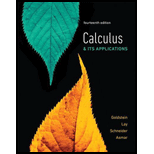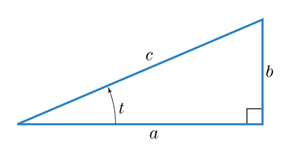
Calculus & Its Applications (14th Edition)
14th Edition
ISBN: 9780134437774
Author: Larry J. Goldstein, David C. Lay, David I. Schneider, Nakhle H. Asmar
Publisher: PEARSON
expand_more
expand_more
format_list_bulleted
Question
Chapter 8.2, Problem 16E
To determine
To calculate: The side

Expert Solution & Answer
Want to see the full answer?
Check out a sample textbook solution
Students have asked these similar questions
Consider the function f(x) = x²-1.
(a) Find the instantaneous rate of change of f(x) at x=1 using the definition of the derivative.
Show all your steps clearly.
(b) Sketch the graph of f(x) around x = 1. Draw the secant line passing through the points on the
graph where x 1 and x->
1+h (for a small positive value of h, illustrate conceptually). Then,
draw the tangent line to the graph at x=1. Explain how the slope of the tangent line relates to the
value you found in part (a).
(c) In a few sentences, explain what the instantaneous rate of change of f(x) at x = 1 represents in
the context of the graph of f(x). How does the rate of change of this function vary at different
points?
1. The graph of ƒ is given. Use the graph to evaluate each of the following values. If a value does not exist,
state that fact.
и
(a) f'(-5)
(b) f'(-3)
(c) f'(0)
(d) f'(5)
2. Find an equation of the tangent line to the graph of y = g(x) at x = 5 if g(5) = −3 and g'(5)
=
4.
-
3. If an equation of the tangent line to the graph of y = f(x) at the point where x 2 is y = 4x — 5, find ƒ(2)
and f'(2).
Does the series converge or diverge
Chapter 8 Solutions
Calculus & Its Applications (14th Edition)
Ch. 8.1 - A right triangle has one angle of /3 radians. What...Ch. 8.1 - Prob. 2CYUCh. 8.1 - Prob. 1ECh. 8.1 - Prob. 2ECh. 8.1 - Prob. 3ECh. 8.1 - Prob. 4ECh. 8.1 - Give the radian measure of each angle described.Ch. 8.1 - Prob. 6ECh. 8.1 - Prob. 7ECh. 8.1 - Prob. 8E
Ch. 8.1 - Prob. 9ECh. 8.1 - Prob. 10ECh. 8.1 - Prob. 11ECh. 8.1 - Prob. 12ECh. 8.1 - Prob. 13ECh. 8.1 - Prob. 14ECh. 8.1 - Prob. 15ECh. 8.1 - Prob. 16ECh. 8.1 - Prob. 17ECh. 8.1 - Prob. 18ECh. 8.2 - Find cost, where t is the radian measure of the...Ch. 8.2 - Prob. 2CYUCh. 8.2 - Prob. 1ECh. 8.2 - Prob. 2ECh. 8.2 - Prob. 3ECh. 8.2 - Prob. 4ECh. 8.2 - In Exercises 112, give the values of sint and...Ch. 8.2 - Prob. 6ECh. 8.2 - Prob. 7ECh. 8.2 - Prob. 8ECh. 8.2 - Prob. 9ECh. 8.2 - Prob. 10ECh. 8.2 - Prob. 11ECh. 8.2 - Prob. 12ECh. 8.2 - Prob. 13ECh. 8.2 - Prob. 14ECh. 8.2 - Prob. 15ECh. 8.2 - Prob. 16ECh. 8.2 - Prob. 17ECh. 8.2 - Prob. 18ECh. 8.2 - Prob. 19ECh. 8.2 - Prob. 20ECh. 8.2 - Prob. 21ECh. 8.2 - Prob. 22ECh. 8.2 - Prob. 23ECh. 8.2 - Prob. 24ECh. 8.2 - Prob. 25ECh. 8.2 - Prob. 26ECh. 8.2 - Prob. 27ECh. 8.2 - Prob. 28ECh. 8.2 - Prob. 29ECh. 8.2 - Prob. 30ECh. 8.2 - Prob. 31ECh. 8.2 - Prob. 32ECh. 8.2 - Prob. 33ECh. 8.2 - Prob. 34ECh. 8.2 - Prob. 35ECh. 8.2 - Prob. 36ECh. 8.2 - Prob. 37ECh. 8.2 - Prob. 38ECh. 8.2 - Prob. 39ECh. 8.2 - Prob. 40ECh. 8.2 - Prob. 41ECh. 8.2 - In any given locality, the length of daylight...Ch. 8.3 - Differentiate y=2sin[t2+(/6)].Ch. 8.3 - Prob. 2CYUCh. 8.3 - Prob. 1ECh. 8.3 - Prob. 2ECh. 8.3 - Prob. 3ECh. 8.3 - Prob. 4ECh. 8.3 - Differentiate (with respect to t or x): y=2cos3tCh. 8.3 - Differentiate (with respect to t or x): y=sin3t3Ch. 8.3 - Prob. 7ECh. 8.3 - Differentiate (with respect to t or x): y=tcostCh. 8.3 - Prob. 9ECh. 8.3 - Prob. 10ECh. 8.3 - Differentiate (with respect to t or x): y=cos3tCh. 8.3 - Prob. 12ECh. 8.3 - Prob. 13ECh. 8.3 - Prob. 14ECh. 8.3 - Prob. 15ECh. 8.3 - Prob. 16ECh. 8.3 - Prob. 17ECh. 8.3 - Prob. 18ECh. 8.3 - Prob. 19ECh. 8.3 - Prob. 20ECh. 8.3 - Prob. 21ECh. 8.3 - Prob. 22ECh. 8.3 - Prob. 23ECh. 8.3 - Prob. 24ECh. 8.3 - Prob. 25ECh. 8.3 - Prob. 26ECh. 8.3 - Prob. 27ECh. 8.3 - Prob. 28ECh. 8.3 - Prob. 29ECh. 8.3 - Prob. 30ECh. 8.3 - Prob. 31ECh. 8.3 - Prob. 32ECh. 8.3 - Prob. 33ECh. 8.3 - Prob. 34ECh. 8.3 - Prob. 35ECh. 8.3 - Prob. 36ECh. 8.3 - Prob. 37ECh. 8.3 - Prob. 38ECh. 8.3 - Prob. 39ECh. 8.3 - Prob. 40ECh. 8.3 - Prob. 41ECh. 8.3 - Prob. 42ECh. 8.3 - Prob. 43ECh. 8.3 - Prob. 44ECh. 8.3 - Prob. 45ECh. 8.3 - Prob. 46ECh. 8.3 - Prob. 47ECh. 8.3 - Prob. 48ECh. 8.3 - Prob. 49ECh. 8.3 - Prob. 50ECh. 8.3 - Prob. 51ECh. 8.3 - Average Daylight Hours The number of hours of...Ch. 8.4 - Prob. 1CYUCh. 8.4 - Prob. 2CYUCh. 8.4 - Prob. 1ECh. 8.4 - Prob. 2ECh. 8.4 - Prob. 3ECh. 8.4 - Prob. 4ECh. 8.4 - Prob. 5ECh. 8.4 - Prob. 6ECh. 8.4 - Prob. 7ECh. 8.4 - In Exercises 310, give the values of tant and...Ch. 8.4 - Prob. 9ECh. 8.4 - Prob. 10ECh. 8.4 - Prob. 11ECh. 8.4 - The angle of elevation from an observer to the top...Ch. 8.4 - Prob. 13ECh. 8.4 - Prob. 14ECh. 8.4 - Prob. 15ECh. 8.4 - Prob. 16ECh. 8.4 - Prob. 17ECh. 8.4 - Prob. 18ECh. 8.4 - Prob. 19ECh. 8.4 - Prob. 20ECh. 8.4 - Prob. 21ECh. 8.4 - Prob. 22ECh. 8.4 - Prob. 23ECh. 8.4 - Prob. 24ECh. 8.4 - Prob. 25ECh. 8.4 - Prob. 26ECh. 8.4 - Prob. 27ECh. 8.4 - Prob. 28ECh. 8.4 - Prob. 29ECh. 8.4 - Prob. 30ECh. 8.4 - Prob. 31ECh. 8.4 - Prob. 32ECh. 8.4 - Prob. 33ECh. 8.4 - Prob. 34ECh. 8.4 - Prob. 35ECh. 8.4 - Prob. 36ECh. 8.4 - Prob. 37ECh. 8.4 - Prob. 38ECh. 8.4 - Prob. 39ECh. 8.4 - Prob. 40ECh. 8 - Explain the radian measure of an angle.Ch. 8 - Prob. 2CCECh. 8 - Prob. 3CCECh. 8 - Prob. 4CCECh. 8 - Prob. 5CCECh. 8 - Prob. 6CCECh. 8 - Prob. 7CCECh. 8 - Prob. 8CCECh. 8 - Prob. 9CCECh. 8 - Prob. 10CCECh. 8 - Prob. 1RECh. 8 - Prob. 2RECh. 8 - Prob. 3RECh. 8 - Prob. 4RECh. 8 - Prob. 5RECh. 8 - Prob. 6RECh. 8 - Prob. 7RECh. 8 - Prob. 8RECh. 8 - Prob. 9RECh. 8 - Prob. 10RECh. 8 - Prob. 11RECh. 8 - Prob. 12RECh. 8 - Prob. 13RECh. 8 - Prob. 14RECh. 8 - Prob. 15RECh. 8 - Prob. 16RECh. 8 - Prob. 17RECh. 8 - Prob. 18RECh. 8 - Prob. 19RECh. 8 - Prob. 20RECh. 8 - Prob. 21RECh. 8 - Prob. 22RECh. 8 - Prob. 23RECh. 8 - Prob. 24RECh. 8 - Prob. 25RECh. 8 - Prob. 26RECh. 8 - Prob. 27RECh. 8 - Prob. 28RECh. 8 - Prob. 29RECh. 8 - Prob. 30RECh. 8 - Prob. 31RECh. 8 - Prob. 32RECh. 8 - Prob. 33RECh. 8 - Prob. 34RECh. 8 - Prob. 35RECh. 8 - Differentiate (with respect to t or x): y=ln(cosx)Ch. 8 - Prob. 37RECh. 8 - Prob. 38RECh. 8 - Prob. 39RECh. 8 - Prob. 40RECh. 8 - Prob. 41RECh. 8 - Prob. 42RECh. 8 - Prob. 43RECh. 8 - Prob. 44RECh. 8 - Prob. 45RECh. 8 - Prob. 46RECh. 8 - Prob. 47RECh. 8 - Prob. 48RECh. 8 - Prob. 49RECh. 8 - Prob. 50RECh. 8 - Prob. 51RECh. 8 - Prob. 52RECh. 8 - Prob. 53RECh. 8 - Prob. 54RECh. 8 - Prob. 55RECh. 8 - Prob. 56RECh. 8 - Prob. 57RECh. 8 - Prob. 58RECh. 8 - Prob. 59RECh. 8 - Prob. 60RECh. 8 - Prob. 61RECh. 8 - Prob. 62RECh. 8 - Prob. 63RECh. 8 - Prob. 64RECh. 8 - Prob. 65RECh. 8 - Prob. 66RECh. 8 - Prob. 67RECh. 8 - In Fig. 2: Find the Shaded area A2.Ch. 8 - Prob. 69RECh. 8 - Prob. 70RECh. 8 - Prob. 71RECh. 8 - Prob. 72RECh. 8 - Prob. 73RECh. 8 - Prob. 74RECh. 8 - Prob. 75RECh. 8 - Prob. 76RECh. 8 - Evaluate the given integral. [ Hint: Use identity...Ch. 8 - Prob. 78RECh. 8 - Prob. 79RECh. 8 - Prob. 80RE
Knowledge Booster
Learn more about
Need a deep-dive on the concept behind this application? Look no further. Learn more about this topic, calculus and related others by exploring similar questions and additional content below.Similar questions
- Suppose that a particle moves along a straight line with velocity v (t) = 62t, where 0 < t <3 (v(t) in meters per second, t in seconds). Find the displacement d (t) at time t and the displacement up to t = 3. d(t) ds = ["v (s) da = { The displacement up to t = 3 is d(3)- meters.arrow_forwardLet f (x) = x², a 3, and b = = 4. Answer exactly. a. Find the average value fave of f between a and b. fave b. Find a point c where f (c) = fave. Enter only one of the possible values for c. c=arrow_forwardplease do Q3arrow_forward
- Use the properties of logarithms, given that In(2) = 0.6931 and In(3) = 1.0986, to approximate the logarithm. Use a calculator to confirm your approximations. (Round your answers to four decimal places.) (a) In(0.75) (b) In(24) (c) In(18) 1 (d) In ≈ 2 72arrow_forwardFind the indefinite integral. (Remember the constant of integration.) √tan(8x) tan(8x) sec²(8x) dxarrow_forwardFind the indefinite integral by making a change of variables. (Remember the constant of integration.) √(x+4) 4)√6-x dxarrow_forward
- a -> f(x) = f(x) = [x] show that whether f is continuous function or not(by using theorem) Muslim_mathsarrow_forwardUse Green's Theorem to evaluate F. dr, where F = (√+4y, 2x + √√) and C consists of the arc of the curve y = 4x - x² from (0,0) to (4,0) and the line segment from (4,0) to (0,0).arrow_forwardEvaluate F. dr where F(x, y, z) = (2yz cos(xyz), 2xzcos(xyz), 2xy cos(xyz)) and C is the line π 1 1 segment starting at the point (8, ' and ending at the point (3, 2 3'6arrow_forward
arrow_back_ios
SEE MORE QUESTIONS
arrow_forward_ios
Recommended textbooks for you
 Mathematics For Machine TechnologyAdvanced MathISBN:9781337798310Author:Peterson, John.Publisher:Cengage Learning,
Mathematics For Machine TechnologyAdvanced MathISBN:9781337798310Author:Peterson, John.Publisher:Cengage Learning, Trigonometry (MindTap Course List)TrigonometryISBN:9781305652224Author:Charles P. McKeague, Mark D. TurnerPublisher:Cengage Learning
Trigonometry (MindTap Course List)TrigonometryISBN:9781305652224Author:Charles P. McKeague, Mark D. TurnerPublisher:Cengage Learning Elementary Geometry For College Students, 7eGeometryISBN:9781337614085Author:Alexander, Daniel C.; Koeberlein, Geralyn M.Publisher:Cengage,
Elementary Geometry For College Students, 7eGeometryISBN:9781337614085Author:Alexander, Daniel C.; Koeberlein, Geralyn M.Publisher:Cengage, Algebra: Structure And Method, Book 1AlgebraISBN:9780395977224Author:Richard G. Brown, Mary P. Dolciani, Robert H. Sorgenfrey, William L. ColePublisher:McDougal LittellAlgebra & Trigonometry with Analytic GeometryAlgebraISBN:9781133382119Author:SwokowskiPublisher:Cengage
Algebra: Structure And Method, Book 1AlgebraISBN:9780395977224Author:Richard G. Brown, Mary P. Dolciani, Robert H. Sorgenfrey, William L. ColePublisher:McDougal LittellAlgebra & Trigonometry with Analytic GeometryAlgebraISBN:9781133382119Author:SwokowskiPublisher:Cengage

Mathematics For Machine Technology
Advanced Math
ISBN:9781337798310
Author:Peterson, John.
Publisher:Cengage Learning,

Trigonometry (MindTap Course List)
Trigonometry
ISBN:9781305652224
Author:Charles P. McKeague, Mark D. Turner
Publisher:Cengage Learning

Elementary Geometry For College Students, 7e
Geometry
ISBN:9781337614085
Author:Alexander, Daniel C.; Koeberlein, Geralyn M.
Publisher:Cengage,

Algebra: Structure And Method, Book 1
Algebra
ISBN:9780395977224
Author:Richard G. Brown, Mary P. Dolciani, Robert H. Sorgenfrey, William L. Cole
Publisher:McDougal Littell

Algebra & Trigonometry with Analytic Geometry
Algebra
ISBN:9781133382119
Author:Swokowski
Publisher:Cengage

What are the Different Types of Triangles? | Don't Memorise; Author: Don't Memorise;https://www.youtube.com/watch?v=1k0G-Y41jRA;License: Standard YouTube License, CC-BY
Law of Sines AAS, ASA, SSA Ambiguous Case; Author: Mario's Math Tutoring;https://www.youtube.com/watch?v=FPVGb-yWj3s;License: Standard YouTube License, CC-BY
Introduction to Statistics..What are they? And, How Do I Know Which One to Choose?; Author: The Doctoral Journey;https://www.youtube.com/watch?v=HpyRybBEDQ0;License: Standard YouTube License, CC-BY
Triangles | Mathematics Grade 5 | Periwinkle; Author: Periwinkle;https://www.youtube.com/watch?v=zneP1Q7IjgQ;License: Standard YouTube License, CC-BY
What Are Descriptive Statistics And Inferential Statistics?; Author: Amour Learning;https://www.youtube.com/watch?v=MUyUaouisZE;License: Standard Youtube License